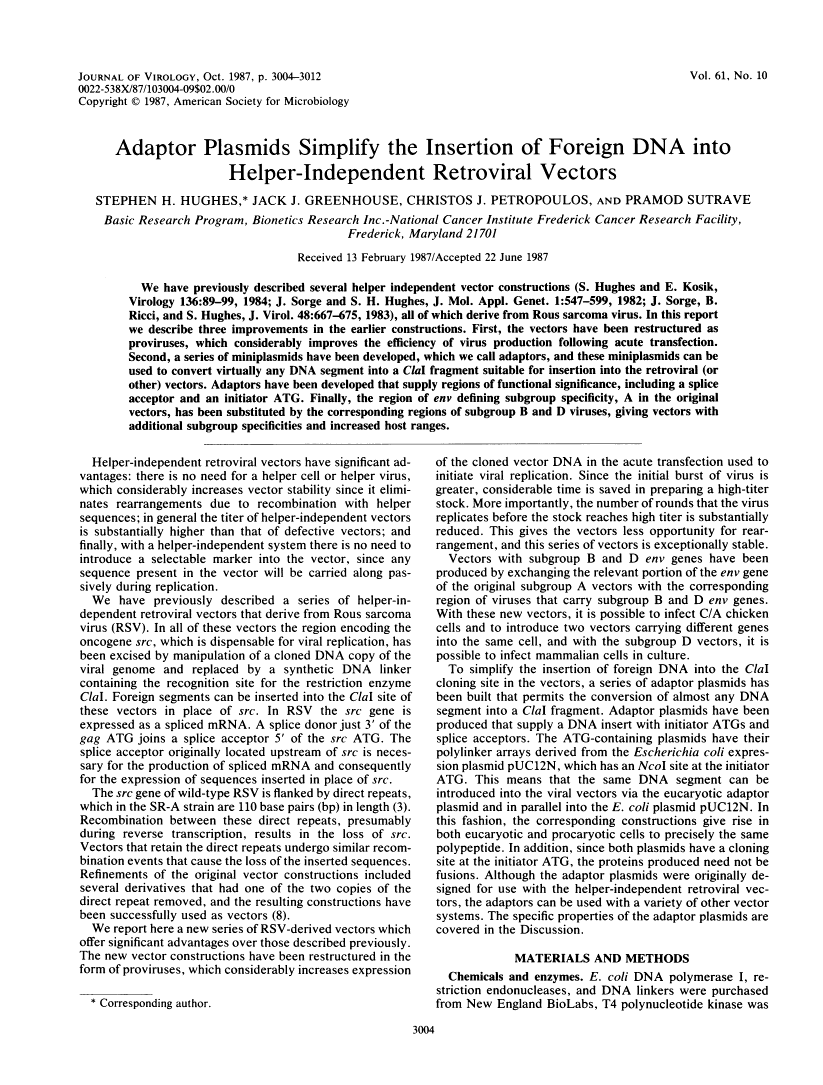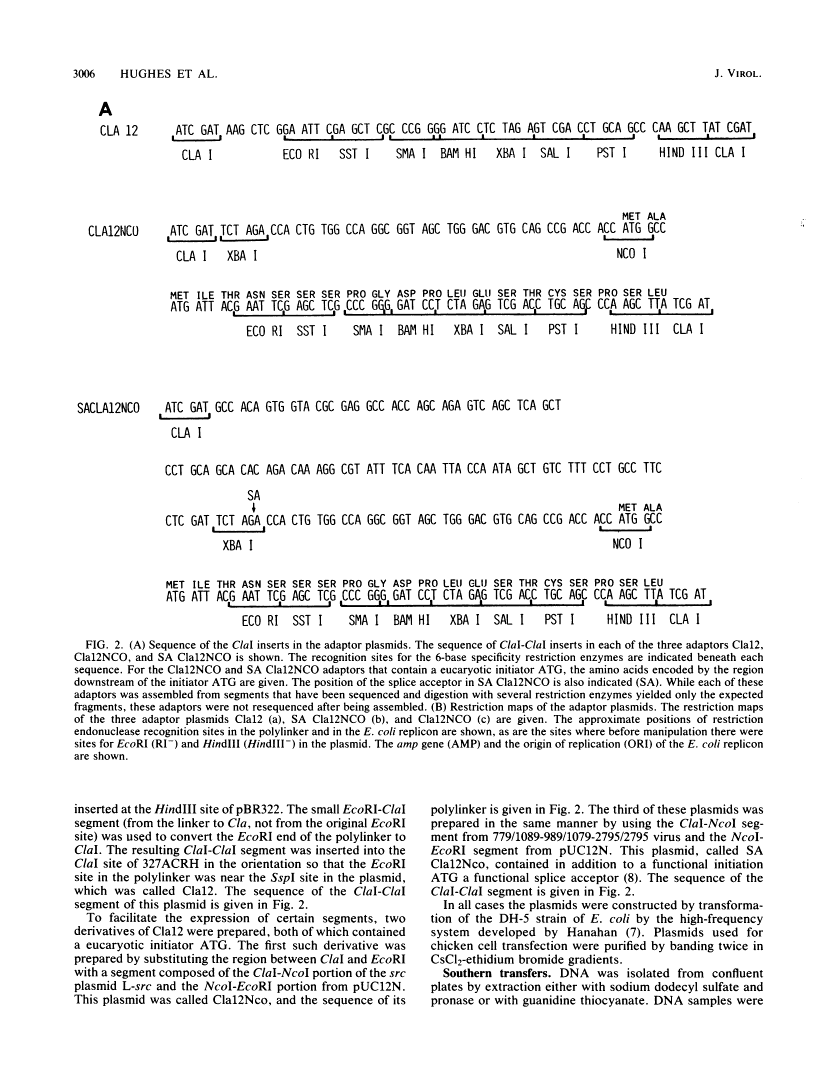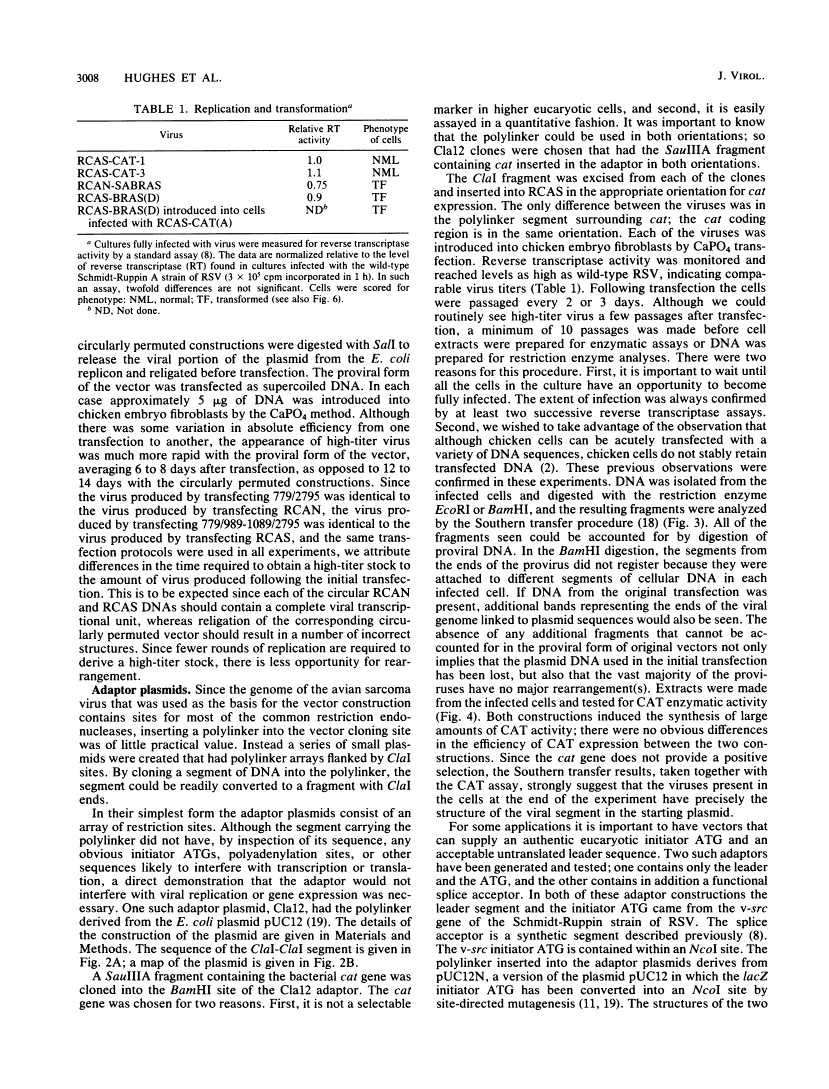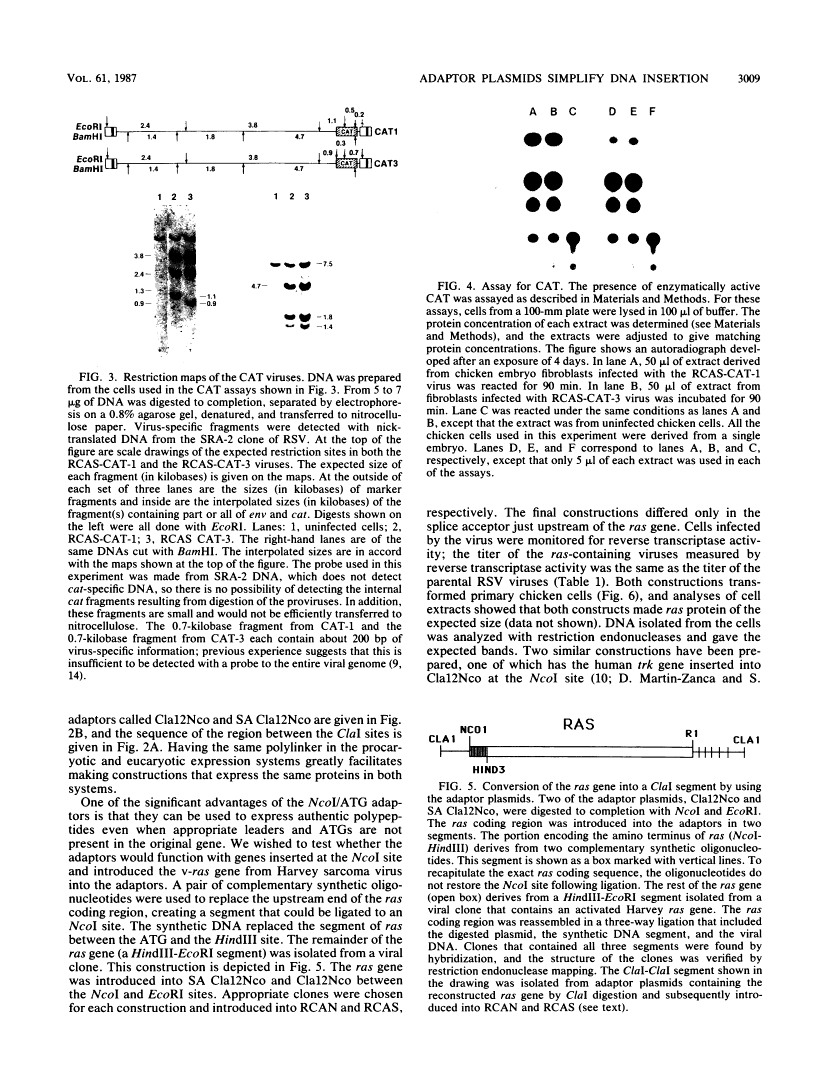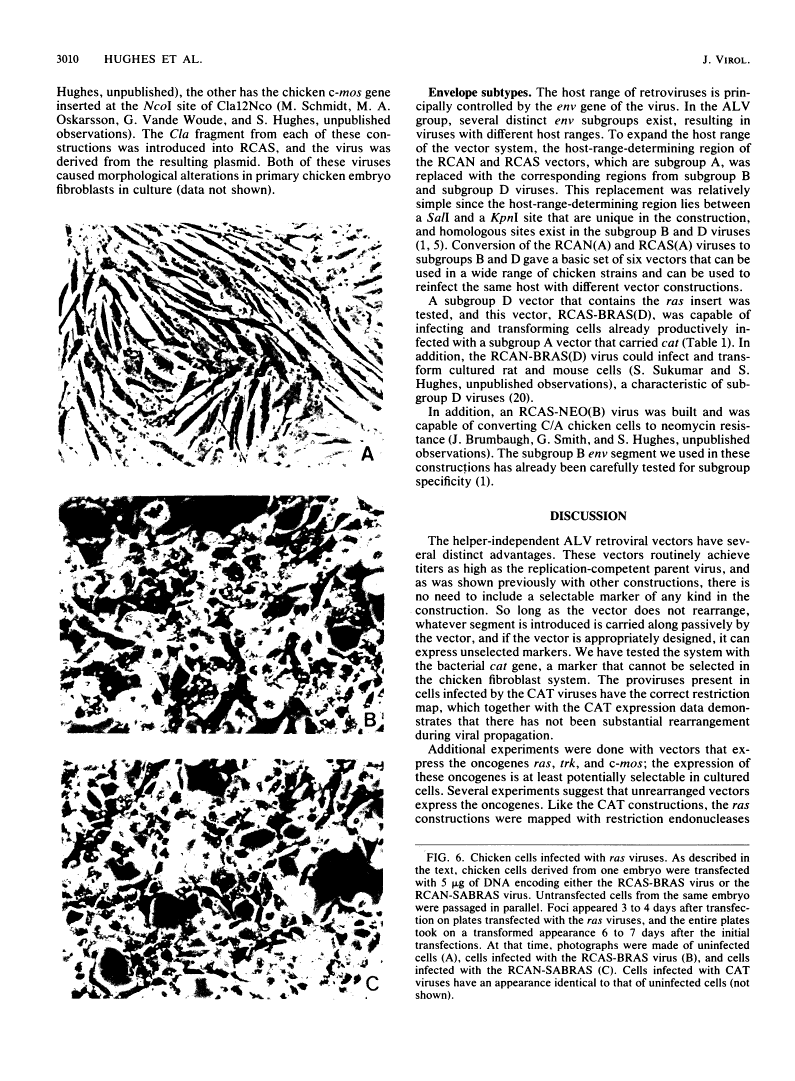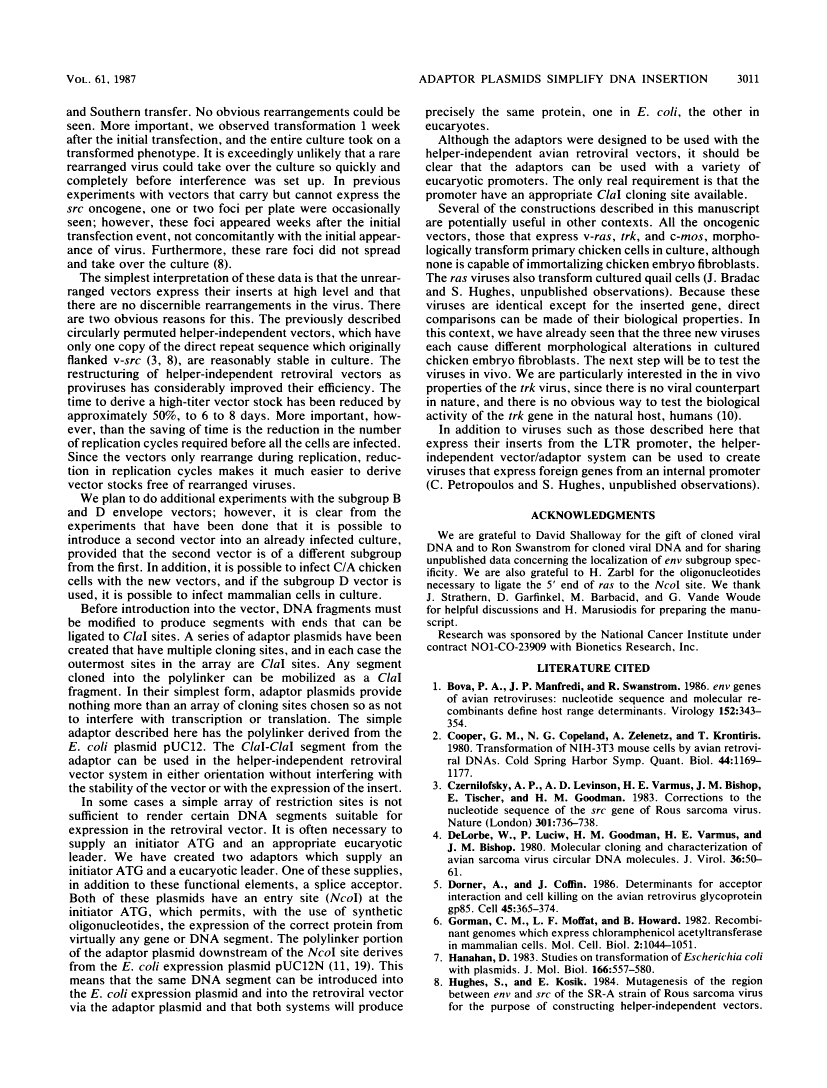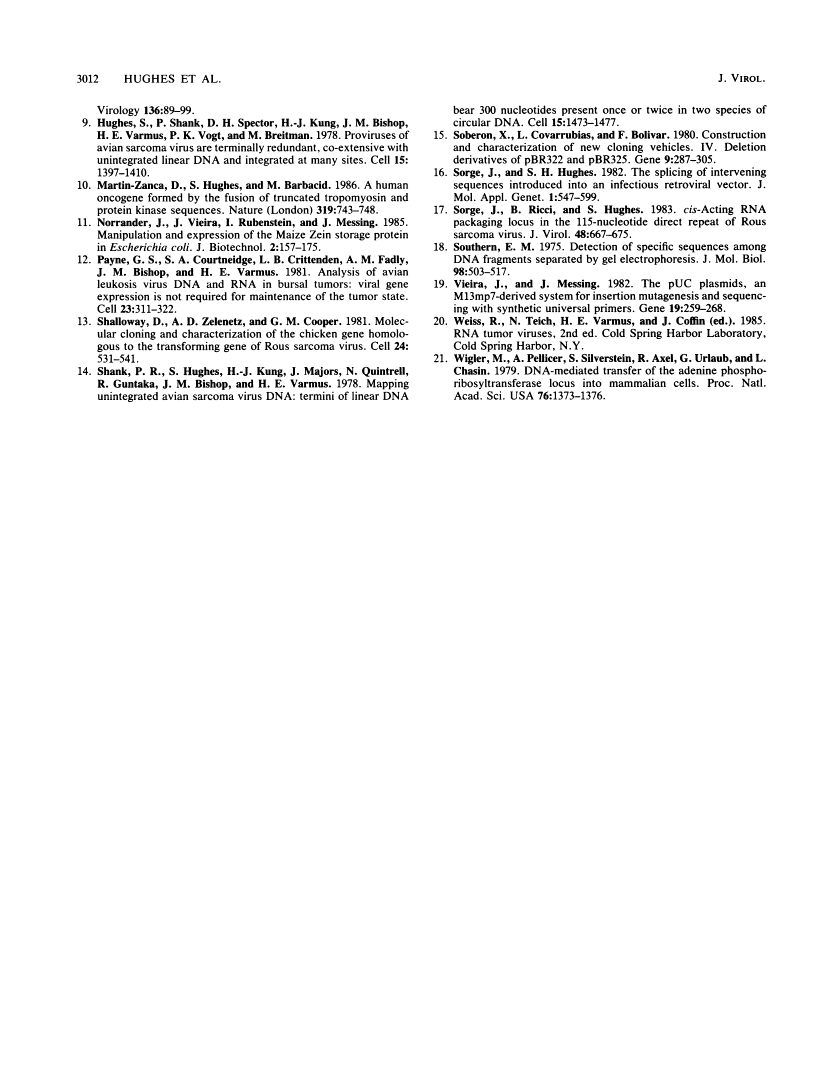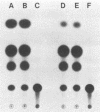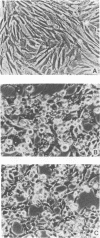Abstract
Free full text

Adaptor plasmids simplify the insertion of foreign DNA into helper-independent retroviral vectors.
Abstract
We have previously described several helper independent vector constructions (S. Hughes and E. Kosik, Virology 136:89-99, 1984; J. Sorge and S. H. Hughes, J. Mol. Appl. Genet. 1:547-599, 1982; J. Sorge, B. Ricci, and S. Hughes, J. Virol. 48:667-675, 1983), all of which derive from Rous sarcoma virus. In this report we describe three improvements in the earlier constructions. First, the vectors have been restructured as proviruses, which considerably improves the efficiency of virus production following acute transfection. Second, a series of miniplasmids have been developed, which we call adaptors, and these miniplasmids can be used to convert virtually any DNA segment into a ClaI fragment suitable for insertion into the retroviral (or other) vectors. Adaptors have been developed that supply regions of functional significance, including a splice acceptor and an initiator ATG. Finally, the region of env defining subgroup specificity, A in the original vectors, has been substituted by the corresponding regions of subgroup B and D viruses, giving vectors with additional subgroup specificities and increased host ranges.
Full text
Full text is available as a scanned copy of the original print version. Get a printable copy (PDF file) of the complete article (2.1M), or click on a page image below to browse page by page. Links to PubMed are also available for Selected References.
Images in this article
Selected References
These references are in PubMed. This may not be the complete list of references from this article.
- Bova CA, Manfredi JP, Swanstrom R. env genes of avian retroviruses: nucleotide sequence and molecular recombinants define host range determinants. Virology. 1986 Jul 30;152(2):343–354. [Abstract] [Google Scholar]
- Cooper GM, Copeland NG, Zelenetz AD, Krontiris T. Transformation of NIH-3T3 mouse cells by avian retroviral DNAs. Cold Spring Harb Symp Quant Biol. 1980;44(Pt 2):1169–1176. [Abstract] [Google Scholar]
- Czernilofsky AP, Levinson AD, Varmus HE, Bishop JM, Tischer E, Goodman H. Corrections to the nucleotide sequence of the src gene of Rous sarcoma virus. Nature. 1983 Feb 24;301(5902):736–738. [Abstract] [Google Scholar]
- DeLorbe WJ, Luciw PA, Goodman HM, Varmus HE, Bishop JM. Molecular cloning and characterization of avian sarcoma virus circular DNA molecules. J Virol. 1980 Oct;36(1):50–61. [Europe PMC free article] [Abstract] [Google Scholar]
- Dorner AJ, Coffin JM. Determinants for receptor interaction and cell killing on the avian retrovirus glycoprotein gp85. Cell. 1986 May 9;45(3):365–374. [Abstract] [Google Scholar]
- Gorman CM, Moffat LF, Howard BH. Recombinant genomes which express chloramphenicol acetyltransferase in mammalian cells. Mol Cell Biol. 1982 Sep;2(9):1044–1051. [Europe PMC free article] [Abstract] [Google Scholar]
- Hanahan D. Studies on transformation of Escherichia coli with plasmids. J Mol Biol. 1983 Jun 5;166(4):557–580. [Abstract] [Google Scholar]
- Hughes SH, Shank PR, Spector DH, Kung HJ, Bishop JM, Varmus HE, Vogt PK, Breitman ML. Proviruses of avian sarcoma virus are terminally redundant, co-extensive with unintegrated linear DNA and integrated at many sites. Cell. 1978 Dec;15(4):1397–1410. [Abstract] [Google Scholar]
- Martin-Zanca D, Hughes SH, Barbacid M. A human oncogene formed by the fusion of truncated tropomyosin and protein tyrosine kinase sequences. Nature. 319(6056):743–748. [Abstract] [Google Scholar]
- Payne GS, Courtneidge SA, Crittenden LB, Fadly AM, Bishop JM, Varmus HE. Analysis of avian leukosis virus DNA and RNA in bursal tumours: viral gene expression is not required for maintenance of the tumor state. Cell. 1981 Feb;23(2):311–322. [Abstract] [Google Scholar]
- Shalloway D, Zelenetz AD, Cooper GM. Molecular cloning and characterization of the chicken gene homologous to the transforming gene of Rous sarcoma virus. Cell. 1981 May;24(2):531–541. [Abstract] [Google Scholar]
- Soberon X, Covarrubias L, Bolivar F. Construction and characterization of new cloning vehicles. IV. Deletion derivatives of pBR322 and pBR325. Gene. 1980 May;9(3-4):287–305. [Abstract] [Google Scholar]
- Sorge J, Hughes SH. Splicing of intervening sequences introduced into an infectious retroviral vector. J Mol Appl Genet. 1982;1(6):547–559. [Abstract] [Google Scholar]
- Sorge J, Ricci W, Hughes SH. cis-Acting RNA packaging locus in the 115-nucleotide direct repeat of Rous sarcoma virus. J Virol. 1983 Dec;48(3):667–675. [Europe PMC free article] [Abstract] [Google Scholar]
- Southern EM. Detection of specific sequences among DNA fragments separated by gel electrophoresis. J Mol Biol. 1975 Nov 5;98(3):503–517. [Abstract] [Google Scholar]
- Vieira J, Messing J. The pUC plasmids, an M13mp7-derived system for insertion mutagenesis and sequencing with synthetic universal primers. Gene. 1982 Oct;19(3):259–268. [Abstract] [Google Scholar]
- Wigler M, Pellicer A, Silverstein S, Axel R, Urlaub G, Chasin L. DNA-mediated transfer of the adenine phosphoribosyltransferase locus into mammalian cells. Proc Natl Acad Sci U S A. 1979 Mar;76(3):1373–1376. [Europe PMC free article] [Abstract] [Google Scholar]
Associated Data
Articles from Journal of Virology are provided here courtesy of American Society for Microbiology (ASM)
Full text links
Read article at publisher's site: https://doi.org/10.1128/jvi.61.10.3004-3012.1987
Read article for free, from open access legal sources, via Unpaywall:
https://jvi.asm.org/content/jvi/61/10/3004.full.pdf
Free after 4 months at jvi.asm.org
http://jvi.asm.org/cgi/reprint/61/10/3004
Free to read at jvi.asm.org
http://jvi.asm.org/cgi/content/abstract/61/10/3004
Citations & impact
Impact metrics
Citations of article over time
Alternative metrics
Smart citations by scite.ai
Explore citation contexts and check if this article has been
supported or disputed.
https://scite.ai/reports/10.1128/jvi.61.10.3004-3012.1987
Article citations
Meningioma animal models: a systematic review and meta-analysis.
J Transl Med, 21(1):764, 28 Oct 2023
Cited by: 0 articles | PMID: 37898750 | PMCID: PMC10612271
Review Free full text in Europe PMC
Non-canonical functions of SNAIL drive context-specific cancer progression.
Nat Commun, 14(1):1201, 07 Mar 2023
Cited by: 8 articles | PMID: 36882420 | PMCID: PMC9992512
Nephronectin-integrin α8 signaling is required for proper migration of periocular neural crest cells during chick corneal development.
Elife, 11:e74307, 03 Mar 2022
Cited by: 2 articles | PMID: 35238772 | PMCID: PMC8916771
CG Dinucleotide Removal in Bioluminescent and Fluorescent Reporters Improves HIV-1 Replication and Reporter Gene Expression for Dual Imaging in Humanized Mice.
J Virol, 95(19):e0044921, 09 Sep 2021
Cited by: 3 articles | PMID: 34232063 | PMCID: PMC8428378
Cas9-expressing chickens and pigs as resources for genome editing in livestock.
Proc Natl Acad Sci U S A, 118(10):e2022562118, 01 Mar 2021
Cited by: 23 articles | PMID: 33658378 | PMCID: PMC7958376
Go to all (403) article citations
Data
Similar Articles
To arrive at the top five similar articles we use a word-weighted algorithm to compare words from the Title and Abstract of each citation.
Mutagenesis of the region between env and src of the SR-A strain of Rous sarcoma virus for the purpose of constructing helper-independent vectors.
Virology, 136(1):89-99, 01 Jul 1984
Cited by: 73 articles | PMID: 6330999
Construction of a helper cell line for avian reticuloendotheliosis virus cloning vectors.
Mol Cell Biol, 3(12):2241-2249, 01 Dec 1983
Cited by: 133 articles | PMID: 6318091 | PMCID: PMC370095
Helper-independent retrovirus vectors with Rous-associated virus type O long terminal repeats.
J Virol, 62(12):4809-4812, 01 Dec 1988
Cited by: 23 articles | PMID: 2460645 | PMCID: PMC253605
Construction and characterization of a packaging cell line for MMTV-based conditional retroviral vectors.
Biochem Biophys Res Commun, 159(3):1191-1198, 01 Mar 1989
Cited by: 18 articles | PMID: 2539144
